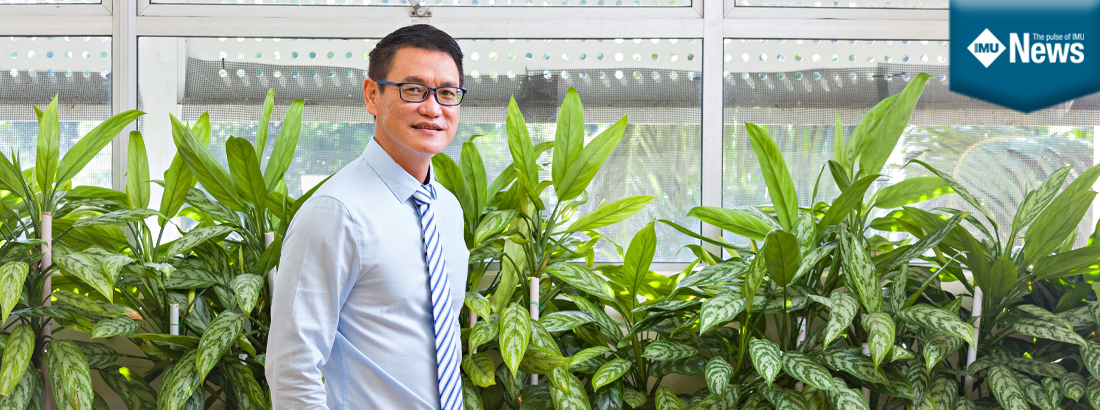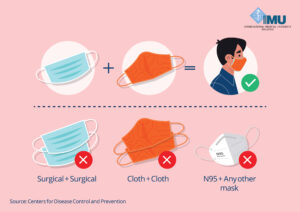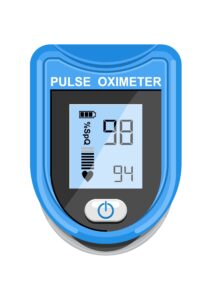More than a year since the first Movement Control Order stopped us in our tracks, we are still learning about the COVID-19 coronavirus. The more we get to know it, the better equipped we are to protect ourselves. Here, Prof Dr James Koh Kwee Choy (in the photo above), Head of the Division of Medicine, School of Medicine at the International Medical University (IMU), talks to us about some of the ways we can double up on protection. There is only one thing that we can be assured of in the new normal—that we will always be faced with change. In the beginning of the pandemic, the virus was thought to only spread through saliva droplets when we spoke, coughed or sneezed. These droplets did not travel very far and that gave us a sense of safety when we abided with social distancing protocols, wore our masks and avoided direct contact. A year and a half later, this wisdom has changed. “It’s evolution of knowledge. Initially, we had expected the COVID-19 coronavirus to behave like all other coronaviruses which were largely disseminated by droplets,” says Prof James. “But we are increasingly seeing people get COVID-19 out of the blue without obvious contact.” Most experts now agree that the virus is also airborne and this has great consequences on how we protect ourselves. For example, where once we were obsessed with wiping down our groceries and spraying surfaces, we now know that surface transmission is less of a threat than the air we breathe.
| Keeping the air safer |
|---|
| With an airborne virus, air circulation in enclosed spaces has become an important focus. Air-conditioned offices, buildings, and modes of transportation are now seen as an even higher risk as viruses in the air will recirculate through air conditioning systems. Prof James says: “If you are indoors, if possible do open the windows. If you have to be in an air-conditioned area, then make sure the air-conditioner has a good filtration system.” We can see this reflected in the latest full movement control order (FMCO). The Total Lockdown SOPs now allow jogging and exercising outdoors with social distancing in place, while the number of people permitted in a car has again been restricted to only what is essential. According to Prof James, air conditioners that use high efficiency particulate air (HEPA) filters such as those used in isolation wards in the hospitals, airplanes and some offices can keep the air safer for us—as long as they are well-maintained. However, the everyday units that we use at home do not usually have these filters, unless we have invested in a high-end one. To help clean the air indoors, we can use air purifiers equipped with HEPA filters. Some come with UV lights that help to destroy viruses. “HEPA filters help to filter out viruses so that they are not recirculated in the air and a UV light destroys the virus,” explains Prof James. Take note though that HEPA filters come in different grades, which in turn provide different efficacy rates. According to Prof James, if you are going to get an air purifier, get a reliable brand as cheaper products may have doubtful efficacy. UV light room sterilisers can also help to destroy viruses. These can be useful in offices and other places with higher foot traffic. They may be useful alternative to or complement wiping surfaces with disinfectants. However, they should only be used with no one in the room as UV rays can damage eyes and cause skin cancer—as well as kill indoor plants! “ I no longer keep plants in my room ever since I bought a UV steriliser. They all turned yellow!” Prof James says his routine is to set a timer when he leaves the office and allow the sterilizer to run automatically for 15 minutes. He then airs the room the next day as the steriliser does not filter out the dead particles. |
Doubling up
Doctors and the Malaysian Ministry of Health have also started to promote double masking. “The idea behind the double mask is to ensure that the mask fits the sides of your face snugly because if the virus is airborne, it can come through the sides of your mask. If you could wear one single mask and make sure it fits nicely to your face, it will also work,” explains Prof James.
To double mask correctly, wear a cloth mask on top of a surgical mask. The cloth mask will help to ensure that the surgical mask sits properly on the face. This also means any method that helps a mask to fit well is worth doing—for example knotting straps or using mask extenders. For children, buy masks in a size that is suitable for them.
Apart from ensuring your mask fits properly, we also need to wear it properly. A mask should not be pulled down below the nose or lifted up when we speak. It should cover both nose and mouth, at all times. “A lot of people just wear masks because they don’t want to get fined,” Prof James says. “They should be thinking of how a mask protects others as well as limits their own risk and exposure.”
Quality, not quantity
Most importantly, we need to ensure that we use good quality masks. The market offers many cheap masks, which although are affordable, may not be effective. Prof James advises: “Look at what is written on the box. It should say surgical masks or for medical use.” The masks should also be 3-ply. This can be checked by cutting a mask and looking for the extra layer inside. “The 3-ply mask has been used by surgeons for decades so it is good enough for community use,” indicating that it is not necessary to use 4-ply masks. There are also the KN95 or the N95 masks that are better in terms of filtration than the surgical mask, “but you have to bear in mind that these masks can be very uncomfortable to wear. You feel very breathless, especially for people who already have respiratory problems, elderly people, people with heart failure and chronic smokers,” says Prof James. Feeling breathless might also be a problem for those who double mask, but it is as simple as listening to your body. “If your body says slow down, don’t rush. Wearing a double mask is going to be a lot more uncomfortable than wearing a single mask, but you can help yourself by doing things a little bit slower. Take deeper breaths, walk a bit slower instead of running and rushing,” Prof James says.
| Refuse to reuse |
|---|
| The biggest worry with masks however is when people reuse them. Many insist on wearing masks more than once and there are even gadgets being sold that promise to sanitise masks to make them reusable. “This is dangerous because a mask is meant to trap droplets and whether those droplets are infected or not, it is still not clean,” explains Prof James. “If you keep your masks long enough, you risk other things growing on it such as bacteria and fungus.” Prof James advises that disposable masks be thrown away immediately after we use them. “Don’t keep used masks in your car or leave them lying around. Any virus trapped on the mask can possibly recirculate in the air,” he says. The same caution needs to be used with cloth masks, which should be washed with soap and water and air-dried after each use. |
Post-Vaccination freedom?
We need to continue to wear masks and practise social distancing even after vaccination with COVID-19 vaccine, advises Prof James as we can still be infected and still infect others. “We may be less contagious after our vaccinations, but if we hug and cry on each other’s shoulders, this makes no difference. We will pass the virus on,” says Prof James. It is important to note that currently the number of people who are not vaccinated far outnumber the ones who are. If others around you are not vaccinated, they can end up with a severe form of COVID-19. In Malaysia, we have recorded cases of the South African, UK and the Indian variants —known to be more transmittable and associated with more severe complications. It is probable that these variants have added to our country’s rising rate of infection and death. “We are seeing people being admitted into hospitals for COVID-19 at Categories Two or Three (Category One being the mildest). Overnight, they can deteriorate to a Category Four or Five where they have to be moved into ICU. There can be very fast deterioration,” warns Prof James.
Monitoring at home
The escalating number of cases has raised fears that have caused people to rush out to buy oximeters.
While this is not harmful, when getting an oximeter, it is imperative that you buy one from a reputable brand. You can also invest in a smart watch that is equipped with an oximeter. “If people buy a poor quality oximeter, it may give you a good reading even if your oxygen level has dropped,” says Prof James. This can then give us a false sense of wellbeing.
An oximeter works by emitting a light through a finger or an ear lobe onto a light-sensing probe in the device. How much light passes through indicates how much oxygen is in the blood. An oxygen level of 98 to 100% is normal but if it falls to 95% and below, it is time to visit your doctor. If you are feeling breathless however, seek medical attention no matter what the oximeter reading is.
People who have lung conditions including long-time smokers, may have lower levels of oxygen than the norm. Oximeter readings can also be affected by dark nail polish, poor nutrition or even the colour of your skin. These are important factors to take into consideration when using the oximeter.
Prevention, always better than cure
It has been a long fight and people are getting fatigued and confused over the ever-changing SOPs. Yet there is one thing that has remained true, and it is the conventional wisdom that prevention is better than cure.
| This means a continued adherence to the now-familiar mantras |
|---|
| Wash your hands. |
| Don’t touch your eyes, mouth and nose. |
| Practise social distancing. |
| Wear a mask, or two. |
| Get vaccinated and encourage others to do so. |
Face shields and goggles are also becoming a familiar sight especially in more crowded places such as a supermarket. These can work as an added layer of protection. Ultimately though, as Prof James says: “If it is not essential, stay home.”
| Can You ‘Kill’ the Virus? |
|---|
| “You can’t kill a virus because the virus is not a living organism. All viruses are like envelopes that contain genetic material. In the case of the coronavirus, the envelope is spherical with spikes on the surface, and within this sphere is genetic material. It doesn’t breathe, it doesn’t need oxygen, it doesn’t produce waste, and it doesn’t need food or water to survive. It doesn’t need anything to survive. It is just protein. So you can’t “kill” it but you can “destroy” the virus—in the same way that you can destroy a car but not kill it,” says Prof James. He adds: “However, a virus does need a living thing in order to replicate itself. For example, when someone dies of COVID-19, the virus in the body still persists. But it can no longer propagate. This is the reason you cannot claim the body of someone who has passed away until they do a test for the virus, and if they had passed away from COVID-19, there will be a special team who handles the body and special protocol to follow.” |
In the News
- Code Blue, 1 July 2021: Covid-19 is in the Air
- New Straits Time, 5 July 2021: Protection against the airborne virus
- Daily Stratis.com, 2 July 2021 – Guide On Living With COVID-19
- i3Investor, 5 July 2021 – Protection against the airborne virus
- mStar, 6 July 2021 – Jangan pandang ringan… ruang tertutup tetap ada risiko jangkitan Covid-19!











